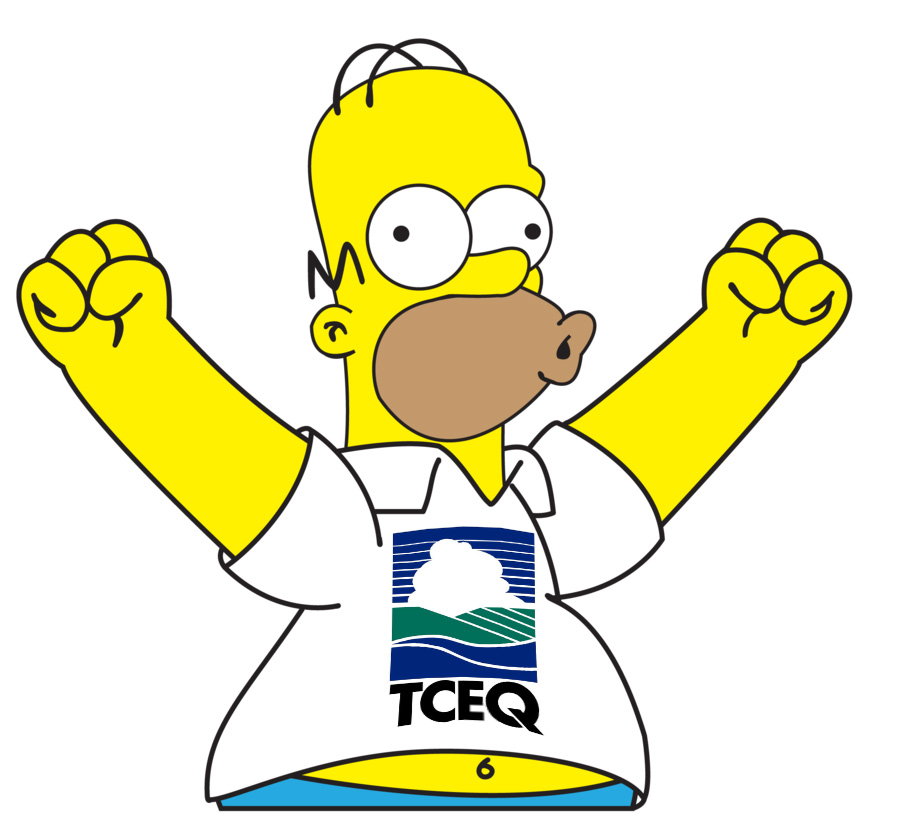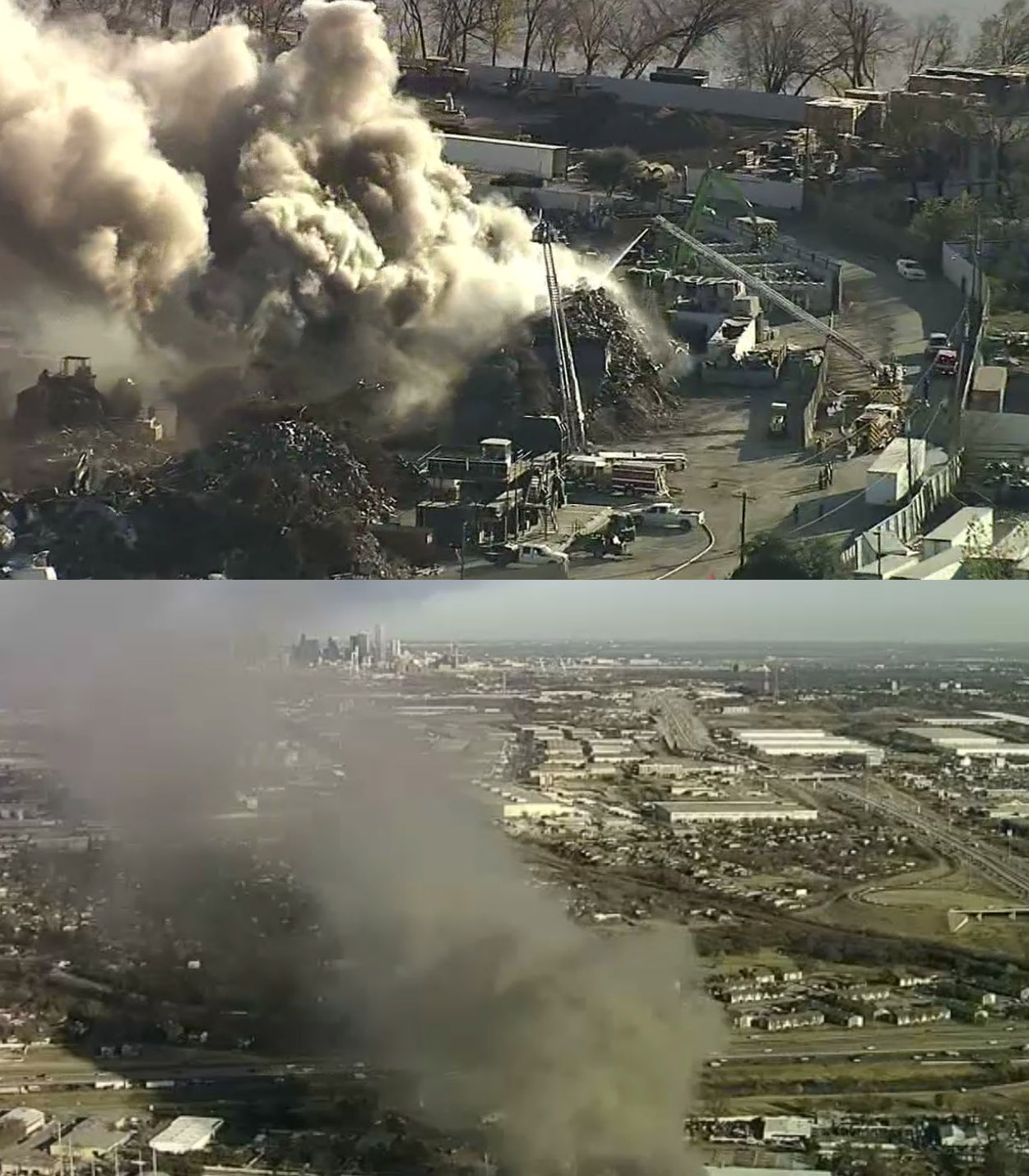Ozone
It’s Only June But DFW Is Already in Violation of the National Smog Standard
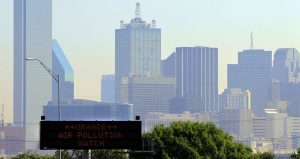 The early start to 100° + days in DFW this spring has meant an early start to high smog levels as well.
The early start to 100° + days in DFW this spring has meant an early start to high smog levels as well.
Although it’s not even summer yet, five official EPA ozone monitoring sites in North Texas have already recorded “4th highest” 8-hour ozone averages that put DFW above the 70 parts per billion federal standard for 2018: Grapevine 73 ppb, Keller 72 ppb, Dallas North (by I-635) 73 ppb, Dallas Hinton (Stemmons Freeway and Mockingbird) 72 ppb, and Denton Airport 72 ppb.
No matter what happens the rest of this 2018 “Ozone Season,” these numbers insure DFW will still be violating the Clean Air Act for a 27th year in a row.
Grapevine and Eagle Mountain Lake monitors have recorded the single highest 8-hour ozone levels in the state so far, at 89 and 92 ppb respectively.
Breathers will have to wait longer to find out how this year’s dosage will affect the all-important regional average, driven recently by the results from the Denton Airport monitor. The regional average is the highest 8-hour average number from any one monitor after averaging the 4th-highest ozone readings from each of the last three years. Extremely high years can be off-set by better years, or visa versa.
Slowly, the DFW regional ozone average has come down from the really bad old days of the 1990’s and early-Oughts. But for the last seven or so years, it’s plateaued in the 80-85 ppb range. As of 2017, Denton had a three-year, regional-leading average of 81 ppb.
Many observers believe the recent stagnation in the decrease of DFW smog is due to increased emissions generated by the Barnett Shale gas play taking up the slack from decreases from other large sources like kilns or cars.
A 2015 UNT study using the State’s own air modeling demonstrated the disproportional impact gas industry sources like compressors had on the area’s historically worst performing monitors in Northwest Tarrant County and Denton, accounting for up to 3 ppb of smog.
Closure or mothballing of three large East Texas coal plants will help keep the numbers down this summer from what they could have been, but it may not be enough to outweigh the impact of continued growth and reluctance by authorities to crack down on other large sources like the gas industry or the Midlothian cement plants.
And this summer’s early smog crisis is yet another reminder about why a 21st Century locally-controlled monitoring system is needed. During this last stretch of 100° + heat, when ozone levels were often climbing by 10 ppb or more per hour, the official EPA/State monitors were up to 2 and a half hours late. At 1 pm, a resident was still looking at 10 am data that was obsolete.
If the federal and state governments won’t do anything but make it more difficult to solve our chronic smog problem, it’s self-defense for local governments to at least be able to warn residents about how bad the air is in real time and at a location near them instead of the other side of town.
Incompetence or Negligence? It Doesn’t Matter: Local Air Pollution Catastrophes on Oct 19th & Dec 11th Show Why DFW Must Have Its Own 21st Century Independent Air Quality Monitoring Network
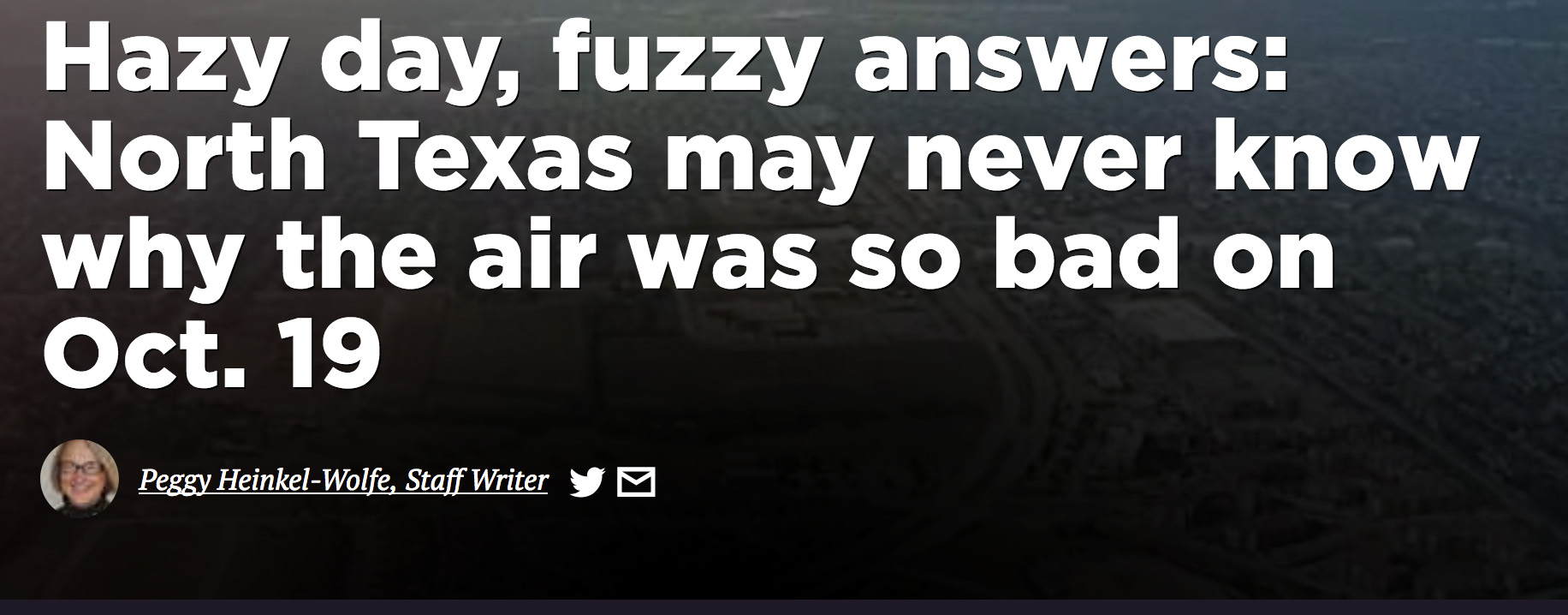
Q: What caused PM and Ozone pollution to spike so high and fast on Oct 19th that health alerts had to be issued from Dallas to Denton?
A: The Texas Commission on Environmental Quality couldn’t care less.
That’s the take-away from Peggy Heinkel-Wolfe’s story that appeared over the weekend in the Denton Record Chronicle.
You may remember we reported on the mystery shortly after it happened and tracked down all the local and non-local suspects cited by officials in the media that day. None of them turned out to be the cause of an air pollution incident that was so potent it raised the entire regional ozone average a whole part per billion and forced PM levels into the triple digits.
Heinkel-Wolfe goes one step further and makes inquires from the TCEQ itself. And the run around she gets is Catch-22 material.
TCEQ says they can’t investigate an air pollution problem unless there’s a known cause. But if there’s a known cause, what you’ve got there really isn’t an investigation any more, it’s an enforcement action, isn’t it?
This article may be the single most compelling case for why DFW needs its own locally-controlled air quality monitoring network. Find it here.
Q: Where are the results of the air samples the Dallas Fire Department supposedly took when a West Dallas Recycling was sending large plumes of black smoke over the surrounding and downwind neighborhoods on December 11th?
A: Nobody seems to know.
A huge pile of metal scrap burned and smoldered for over 24 hours at Sunshine Recycling on Ruder Street in West Dallas on December 11th. Thick plumes of smoke streaked the sky for half a day and into the night.
According to WFAA-TV, a Fire Department Hazardous Materials response team was on site because there were hazardous materials on site – although exactly what those were, or are, remain nameless.
That evening the Dallas City Councilman who represents West Dallas, Omar Narvaez, posted on his FaceBook page that “The Fire Dept has conducted testing and there is no hazardous materials burning.”
Really? Because when a scrap yard like that catches fire, you can bet there’s “hazardous materials” burning whether it’s officially noted or not. Plastic tubing and hoses become Dioxin-generating embers. Used oil has all kinds of metals in it that attach themselves to the smoke particles. Vinyl can generate very toxic fumes. Just the PM pollution from the smoke alone was enough to trigger all kinds of harmful health impacts. Very likely the entire pile of metal waste that was burning that night was indeed “hazardous.”
But OK, you say you took tests and they showed nothing out of the ordinary? Let’s see them. In December Downwinders submitted a Texas Open Records Act request to the City of Dallas for the results of those tests. We’re still waiting. As of today, and despite three phone calls to the Open Records Division of the City Secretary’s office, we still don’t have what it’s supposed to take no more than 10 business days to get. It’s been a month and counting. We’re trying to get some legal help to extract the information. Stay tuned.
For $500 a piece, we can install a dense grid of PM monitors across the region, tie them all together and present the information to the public in a transparent accessible way. It can be locally-controlled, directed by scientists, and independent of political influence.
It would automatically track plumes in real time, not an hour ago. It would give you reliable and specific levels of pollution rather than vague reassurances. It would transfer the power from officialdom to citizenry.
That’s the new Network we’re building. Stay tuned.
A Group That Shouldn’t Be Here…Still Is. Thanks.
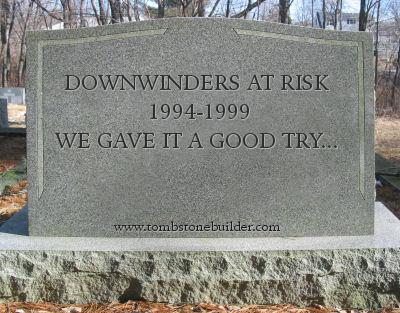 By all rights, there shouldn’t be a Downwinders at Risk around anymore.
By all rights, there shouldn’t be a Downwinders at Risk around anymore.
The life expectancy of a local grassroots group rising up to fight a bad permit is a couple of years if you’re lucky, twice that if you’re extremely lucky.
We’re beginning our 23rd year. Throughout that time, we’ve ridden our share of organizational roller coasters and still managed to disembark with our group intact.
When we lost our hazardous waste permit fight with TXI in 1999. When we fought our Green Cement battles. When we debated taking on lead smelters and gas drilling in addition to cement kilns. Those were tough times.
But this year was among the most disheartening and frustrating… and hopeful and exhilarating. On Inauguration Day, the program work of the last five years centering on DFW smog evaporated with the installation of a hostile EPA. We then lost 50% of our board between January and July through moves, illness, and exhaustion. We weren’t sure we were going to make it to the end of this ride.
But then things started to happen.
15 brave souls signed-up for an inauguration of our own as we began the College of Constructive Hell-Raising as an experiment in cross-movement, cross culture networking. By May’s graduation, there was a consensus it was a successful one and we recruited at least one board member from its alumni.
Our “Science and Socializing” events in June attracted new blood, including young scientists and researchers that wanted to help with 21st Century high-tech air quality monitoring.
We conceived a new campaign centered on Particulate Matter pollution, a pervasive and potent toxin linked to everything from early death to learning disabilities. A toxin we can reduce exposure to without the permission of the EPA or State of Texas. We believe this effort will take us places no DFW environmental group has ever gone before: highway and urban planning, transit and housing policy, as well as the familiar ground of environmental racism and citizen empowerment.
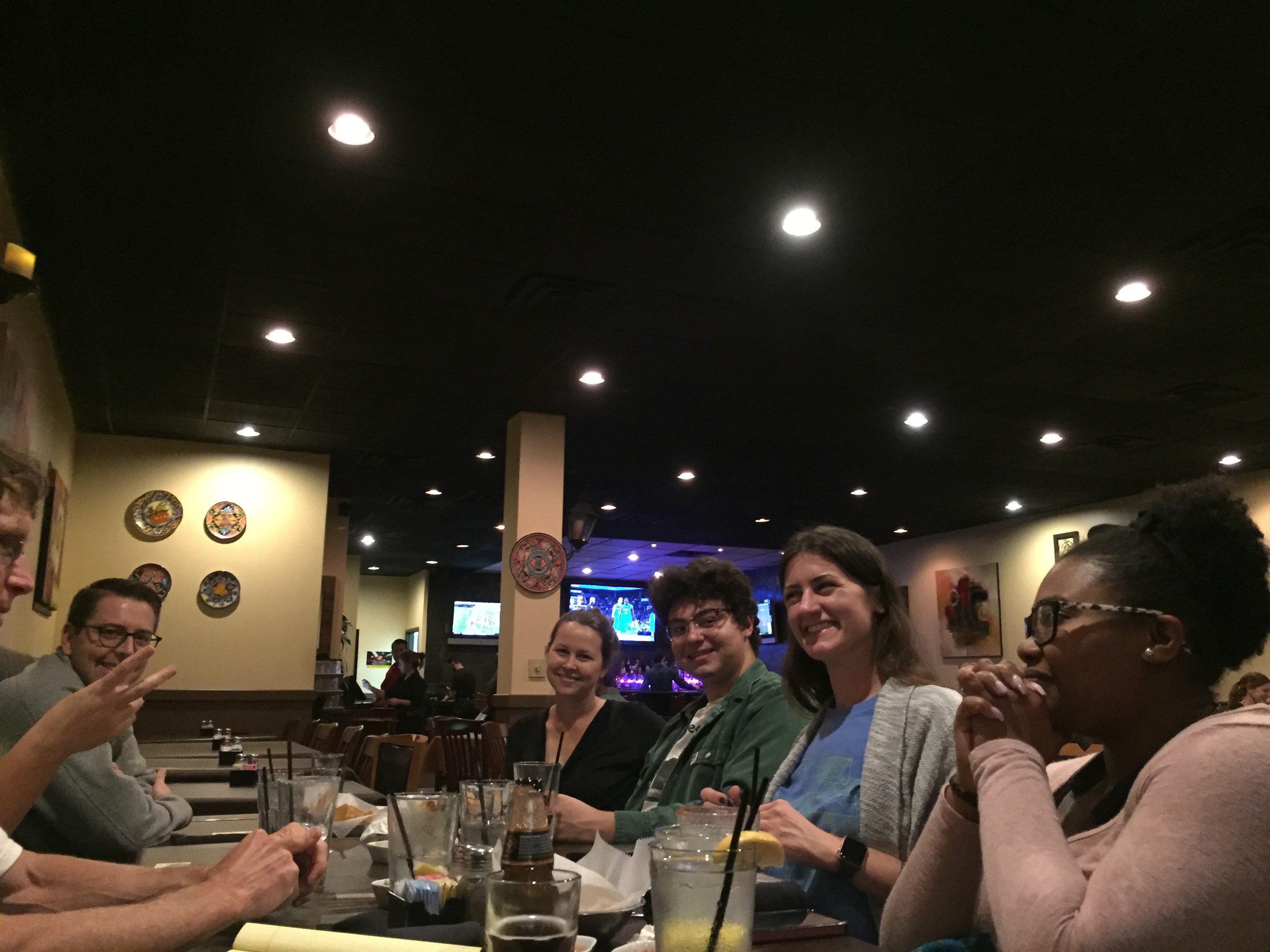
And we’re back to close-to-full board strength, with most of our new members a generation or two younger than the board members they replaced. Twenty somethings are almost in the majority now. We have a board member who was born the same year we were.
In short, Downwinders at Risk as reinvented itself…again.
There’s no better proof of that than what was going on a couple of weekends ago.
In Dallas, the newest members of our board were running the first meeting of our “No Safe Level” Particulate Matter campaign – without Director Jim Schermbeck anywhere in sight.
Meanwhile, in Austin, Associate Program Director Anthony Gonzales was meeting with Libertarian Party officials in an attempt to build a never-before-attempted bi-partisan grassroots alliance to advocate for more “local control” in upcoming Republican Primary races and the 2019 Legislature.
North, in rural Wise County, UNT graduate student Kari Nothiem was working to establish a location for our very own ozone monitor – in the only “non-attainment” county where the state still refuses to monitor for smog. It’s part of a citizens network of new air quality monitors we’re working with UTD and others to establish across North Texas to replace the state’s obsolete system.
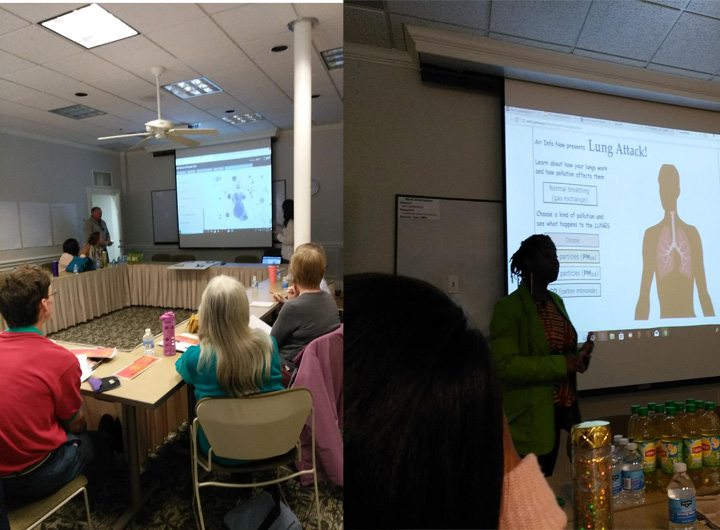
We hope you agree both the geographical and thematic reach of this new Downwinders at Risk is impressive for any group, but especially one that’s entirely dependent on DFW residents and resources. This is our home office. Your neighbors are our board members. This is our only work.
And if you’re reading this, you’re an important reason we’re still here. Even as our mission has broadened and deepened, you’ve been supportive. That’s taken a lot of faith at times. Thank you to each and every board member, volunteer, and contributor.
We started 2017 in suspect shape. We’re ending it with renewed vigor and optimism.
If 2017 was about renewal, 2018 is shaping-up to be a Reveille right out of the gate.
Batch plant permits in Joppa and West Dallas are due to show back up on the Dallas City Council Agenda in January. We’ll be there as part of our campaign to reduce PM pollution and argue that both communities need a bottom-to-top zoning review to better buffer people from pollution.
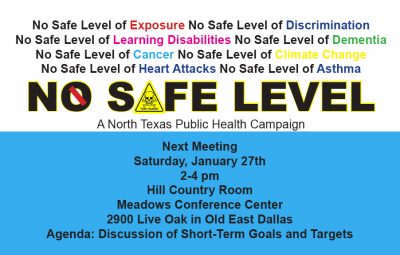
Those fights, plus transit system and school-based initiatives are on the agenda at our next No Safe Level campaign meeting on PM pollution scheduled for Saturday January 27th from 2 to 4 pm at the Meadows Conference Center 2900 Live Oak in Old East Dallas. All are welcome.
It looks like we might have our first vote on a new regional air monitoring network at Dallas Commissioners Court on January 16th – the first step to a truly 21st Century approach directed by local governments.
Later that same day, the 2018 class of our College of Constructive Hell-Raising begins meeting (late-comers still being accepted….)
And if everything goes as planned, we’ll be announcing the creation of a broad left-right coalition working to restore local zoning powers to local governments in Austin sometime next month.

We had a very good Giving Day this year and you may feel as if you’ve paid your clean air resistance dues for 2017. We understand. But if you like the direction the group is going and you want to do some early 2018 voting with your pocketbook, we could sure use the help as our work expands.
Thanks for your continued support and your consideration of a contribution to the cause we’ll try our best to serve for a 23rd consecutive year.
DONATE HERE
Mysterious Catastrophic Air Pollution Episode is Why DFW Needs its Own Air Sensor Network
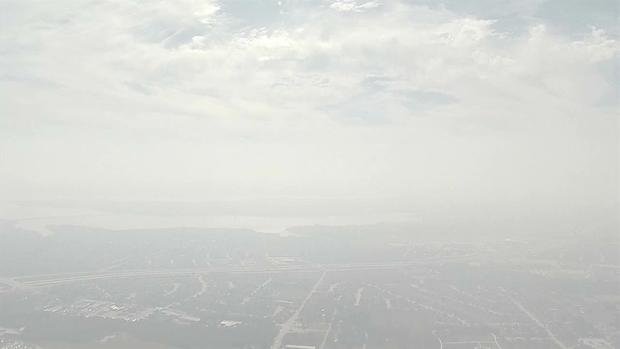
Not quite two weeks ago, on Thursday October 19th, something happened to throw local air quality conditions into the red zone for most of the day.
There was a inexplicable smokey haze extending along the limestone escarpment from Midlothian to Dallas and then north to Denton, sending Particulate Matter pollution soaring to Beijing levels and ozone readings so high the whole regional average went up a part per billion. Countless downwind residents complained to officials, FaceBooked, and Tweeted about “the smell of burning plastic” enveloping their neighborhoods with the smoke, which was so thick many thought the problem was just down the street.
 The 24-hour standard for Particulate Matter Pollution is 150 ug/m3. The annual standard is 12.
The 24-hour standard for Particulate Matter Pollution is 150 ug/m3. The annual standard is 12.

70 ppb is the new ozone standard.
The events took the Texas Commission on Environmental Quality completely by surprise. Commission computer forecasting had not predicted an Ozone Alert Day or warned of heavy PM pollution. Officials were playing catch-up for the rest of the day.
Now almost two weeks later nobody official knows what caused this Really Bad Air Day. Not the EPA. Not the Texas Commission on Environmental Quality. Not the DFW area citizens who breathed in the dirtiest air their lungs have seen all year.
Despite the sophisticated technology available to us in 2017, a single unexpected incident upwind of DFW can throw the entire North Texas air shed into the danger zone with no warning and no clue as to what initiated it.
Readings from state monitors were of no help until damage had already been done. As usual they were two hours or more behind in reporting. The numbers they were displaying at 12 noon were actually taken at 10 am. You had no idea what was going on in real time so that you might better protect yourself or family.
There are only three or four Particulate Matter pollution monitors in all of DFW. Even if you’d wanted to use the state’s current monitoring system to track this mystery plume, you couldn’t have done so. It doesn’t have that capability.
As inquiring reporters called, the TCEQ staff found a variety of things to blame. TCEQ suggested the smoke was from a Bastrop forest fire near Austin. But readings from monitors between Bastrop/Austin and Dallas show there was no problem south of Midlothian that day, while there was a huge problem north of there at the same time. Eyewitnesses who saw the plume on Thursday reported a thick narrow ribbon of a plume you’d see coming off a near-by source, not the sort of diffused cloud you’d expect to witness after traveling more than a hundred miles downwind. And then there’s that “burned-plastic smell.”
Then it was maybe one or more “controlled burns” in the Midlothian-Mansfield area. As it turns out, neither fire department found evidence of any permitted controlled burns in their own jurisdictions that could have cause so much pollution. Midlothian’s single permitted fire for the day was “the size of a coffee table” according to a department employee.
According to the Mansfield Fire Department “a fire” was reported to be located at Kimball Road and Hwy 287 just north of the Midlothian city limits. This is what’s at that intersection:

Please note the caution against open flames. Could a fracking site have produced the kind of particulate matter pollution and haze we saw on October 19th without methane or other kinds of pollution being released en masse as well? It doesn’t seem like it could. But what if the fracking site had been turned into a temporary waste incineration site for the day?
That’s not all. A satellite pic of the intersection and what’s around it reveals Kimball and Hwy 287 to be a kind of rogue’s gallery of potential suspects:
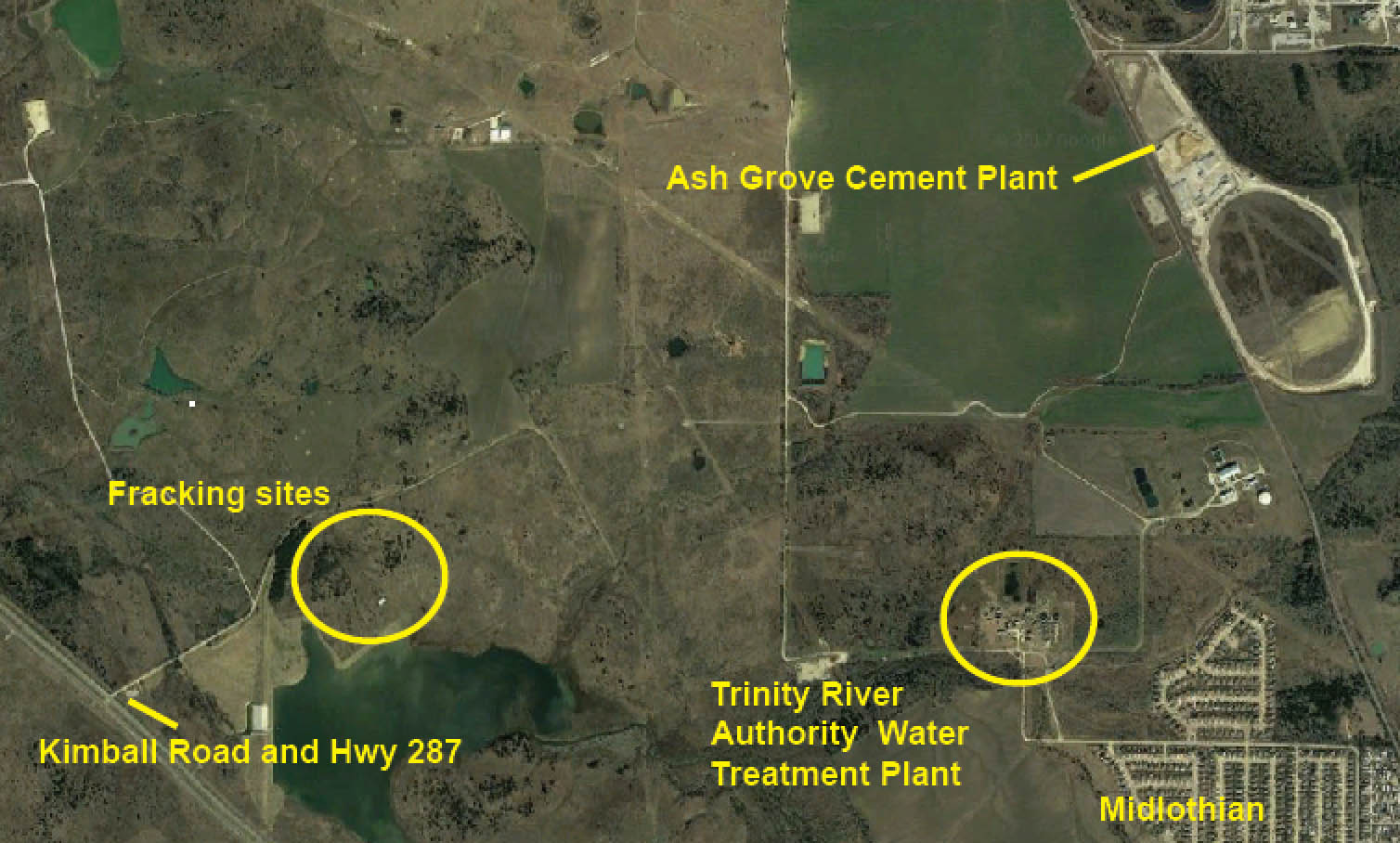
Besides the fracking sites you can be see in mid-drilling on this Google street level tour, the road leads to a Trinity River Authority Wastewater Treatment plant and the back door of the giant Ash Grove cement plant.
TRA is a shadowy, 60-year old regional bureaucracy that owns millions of acres of land, reservoirs, landfills, and wastewater-treatment facilities. It’s been in environmental hot water before. Wastewater treatment accumulates a lot of solids, and the TRA handles a lot of trash. It’s not inconceivable that it had something to do with the October 19th incident by thinking it could get away with an open burn on its own property.
Ditto for Ash Grove. Like the other two cement plants in Midlothian, Ash Grove’s kiln is allowed to burn industrial waste, including used oil, tires and plastics – remember the oft-cited “smell of burning plastic” citizens reported on the 19th? Waste-burning cement plants have had their wastes combust and cause huge fires before and each plant has its own emergency response crew which might be able to put out a fire without calling Midlothian.
There’s no proof Ash Grove, TRA or the fracking sites were the cause of the October 19th public health disaster. But there’s also no proof yet they didn’t cause the problem.
The truth is: there’s no official explanation for what made the air so dangerous to breathe on October 19th .
More truth: As of Friday, October 27th the TECQ had not even opened an official investigation into this matter – which again, sent Particulate Matter pollution to levels not seen outside SE Asia and single-handedly raised the regional ozone level.
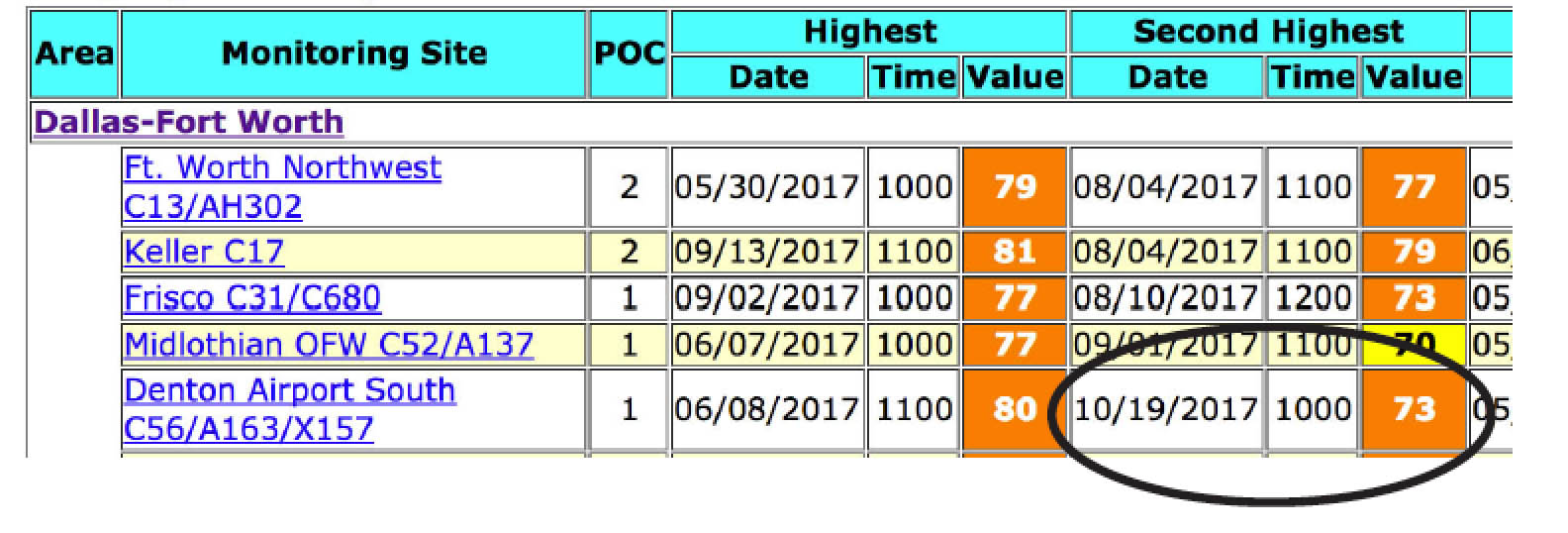
This is why Downwinders at Risk filed the first of what we’re sure will be a series of Texas Open Record Act requests last Friday seeking:
“Any and all printed or electronic documents and electronic media containing information concerning or related to ozone, particulate matter and/or haze air pollution readings and levels in the Dallas-Forth Worth non-attainment area on Thursday, October 19th 2017, including official ozone action warnings issued, complaints filed about air quality in the Dallas-Fort Worth area that day, photographs, satellite images, computer modeling, as well as all material related to any questions, inquiries, or investigations about air quality in DFW on October 19th anyone in the TCEQ, or contracted by TCEQ has been tasked to perform since October 19th or is still performing currently, and e-mails, letters, reports, telephone logs and notes, memos and all other material about October 19th air quality from 6 am Tuesday October 19th to Wednesday October 25th, 2017.”
TCEQ has until November 10th to respond. We’ll keep you posted.
In the meantime, this episode becomes Exhibit A in why DFW needs to catch-up with other metro areas and build its own network of high tech air quality sensors.
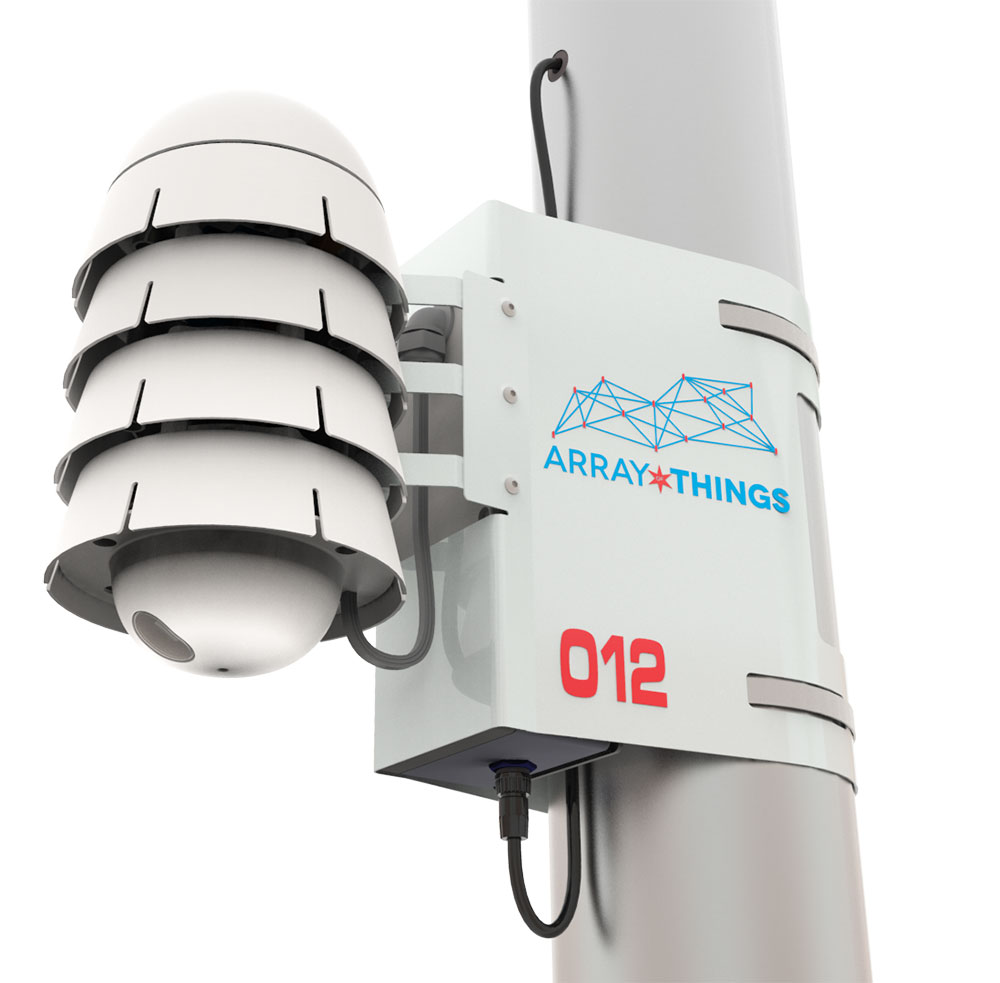
If such a grid had been in place, there would have been a real time warning of the PM and ozone pollution being generated shortly after the it started. There would have been a way to locate the source of the pollution right away and do something about it before it got worse, and there would have been a way to predict the plume’s course and warn those in its path before it got there – not two hours after it arrived.
In this sense a modern sensor grid is actually a pollution prevention device, an investigative tool, and an early warning system all rolled into one.
In a metropolitan area that’s been out of compliance with the Clean air Act for 27 years and counting over 14 million lungs are being held hostage by a state air quality monitoring system left over from the 1990’s. It’s being maintained by a state agency that’s run by polluters, officially thinks smog isn’t bad for you, and is cutting its air monitoring budget.
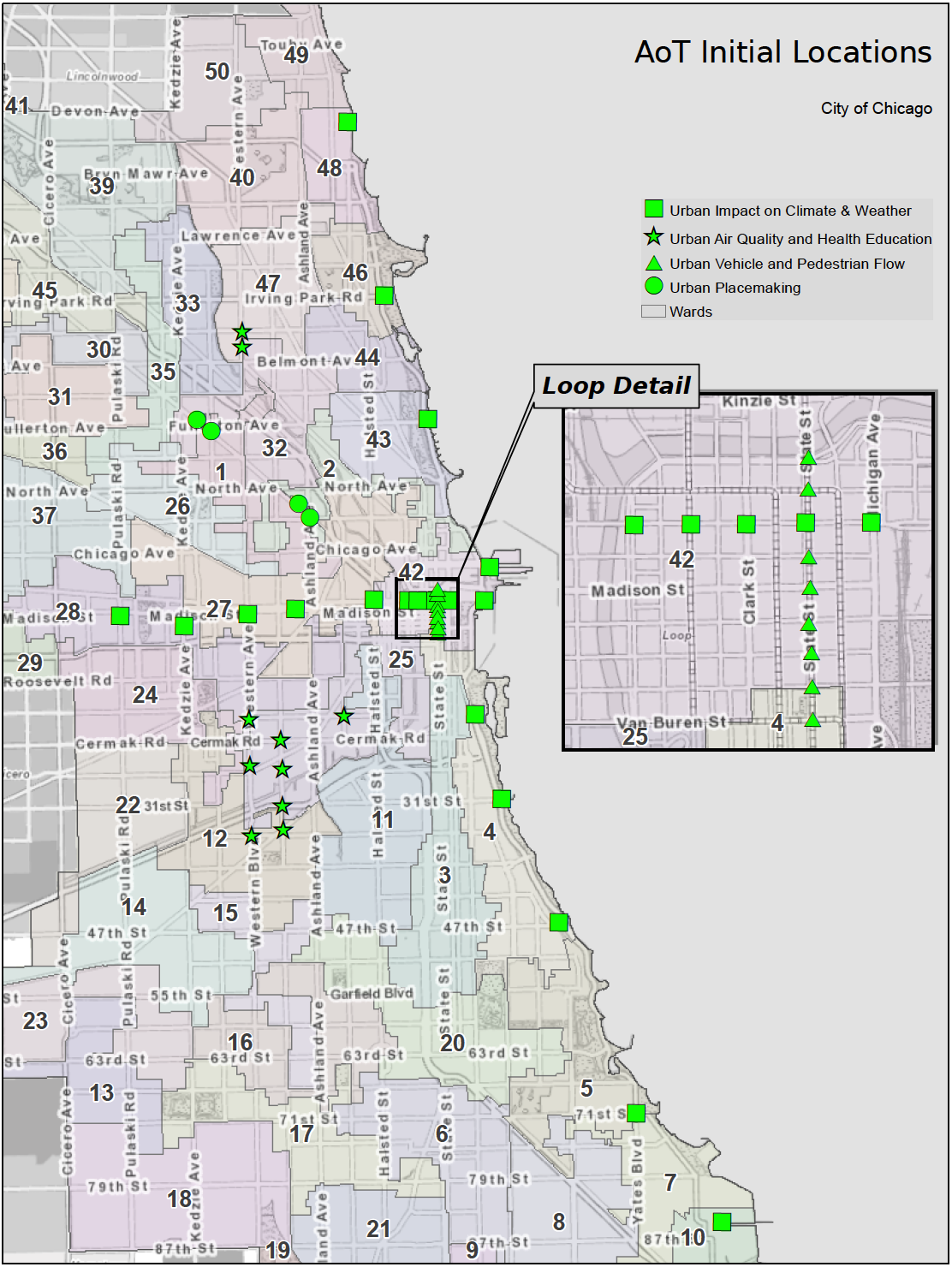 There’s no desire in Austin to update this obsolete system and no money to do so. If DFW officials want to utilize 21st Century technology to help them clean their air, they’re going to have to build their own network of air monitors – exactly the proposal the DFW Air Research Consortium was trying to get funded with a National Science Foundation grant. Close, but no cigar.
There’s no desire in Austin to update this obsolete system and no money to do so. If DFW officials want to utilize 21st Century technology to help them clean their air, they’re going to have to build their own network of air monitors – exactly the proposal the DFW Air Research Consortium was trying to get funded with a National Science Foundation grant. Close, but no cigar.
Without the NSF grant, local officials are going to need to get creative. Are there private businesses who might want to sponsor an app that could tell give you useful air quality info in exchange for naming rights: “Brought to you by the Nissan Leaf DFW Clean Air Network.” Are there local foundations that would contribute? What about local high-tech billionaire Mark Cuban? For less than a million bucks, DFW could have 500 Particulate Matter sensors that would be capable of of pinpointing a problem down to the street address.
Baltimore, Chicago, Chattanooga, Louisville, L.A. , Oakland, and Lafayette, Louisiana are all way ahead of DFW in building out their own local dense grid of air sensors. They’ve done it with a combination of private, government and academic know-how and financing.
We have as much, or more technical expertise and money than any of those locales and we should have more incentive given our chronic air pollution problem. There’s no reason we can’t build our own modern, more protective, more useful way of monitoring air pollution – even if the state isn’t interested. Not only can we do it, but in light of the events of October 19th, it should be considered a necessary act of public health self-defense.
Brown, Big: 1971-2018
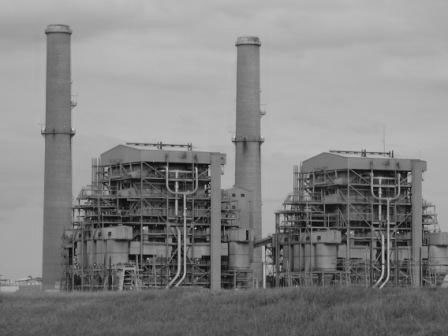 After years of declining fiscal health, the Big Brown lignite coal plant finally succumbed last Friday. An announcement was made by its most recent caretaker, Vistra Energy last Friday morning. The cause of death was obsolescence. It was 47.
After years of declining fiscal health, the Big Brown lignite coal plant finally succumbed last Friday. An announcement was made by its most recent caretaker, Vistra Energy last Friday morning. The cause of death was obsolescence. It was 47.
Controversial from its birth, the 1. 2 Gigawatt Big Brown lived up to its name and was Texas Utilities’ flagship power plant for decades. It began by burning 100% Lignite Coal, the mud-like fossil fuel native to East and Central Texas. By the end however, it was importing thousands of tons of “cleaner” Wyoming Powder Basin Coal in long freight trains to comply with interstate pollution rules.
Along with other coal-fired power plants in East Texas, Big Brown was citied for causing acid rain to by SMU Chemist George Crawford as early as the 1980’s. It was then discovered to be a major contributor t0 Dallas-Fort Worth smog, a fact reinforced by a 2008 study from another SMU professor and former EPA Regional Administrator Dr. Al Armendriz, and more recently by Dallas Medical Society’s Dr. Robert Haley in his 2015 report on ozone levels and public health in DFW. Public Citizen/Texas and the Sierra Club had been particularly hostile to the plant’s continued operation.
As coal lost favor as an energy source, Big Brown’s estimated lifespan had been the subject of countless rumors over the last decade. Towards the end the plant consistently refused modern technology which might have prolonged its life, such as Sulfur Dioxide scrubbers and Selective Catalytic Reduction for smog pollution.
The timing of the plant’s demise was seen as a major embarrassment to officials in the Trump Administration, who’ve promised to promote coal. On the same day as Vistra’s notice about Big Brown’s demise, Trump appointed known fossil fuel promoter Kathleen Hartnett White to lead the White House Council on Environmental Quality.
It was the third Texas coal plant to expire in less than a week. Big Brown was preceded in passing by the Monticello lignite plant, which announced its departure on October 6th. Vistra said its smaller Sandlow power plant near Bastrop was to be closed in 2018 as well.
In 2016, these three coal plants emitted a total of 166 million pounds of sulfur dioxide, 24 million pounds of nitrogen oxide, and 21 million tons of carbon dioxide pollution. Their absence during the 2018 “ozone season” could be the first time DFW stands a chance of complying with the Clean Air Act in 27 years.
Survivors, for now, include the coal-fired Martin Lake and Oak Grove power plants, as well as NRG’s Limestone power plant, southeast of DFW.
Meet Our New Scientist
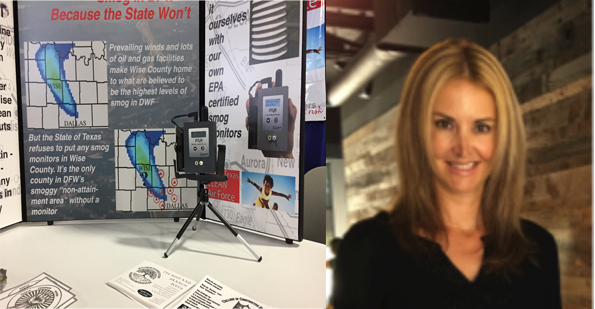 Downwinders’ Wise County Ozone Project Gets A Director
Downwinders’ Wise County Ozone Project Gets A Director
Downwinders at Risk is proud to announce Kari Northeim, a doctoral student in Environmental Sciences at the University of North Texas, has agreed to become our Wise County Ozone Project Director.
Kari brings an impressive resume and a rigorous level of scientific methodology to the use of our two new EPA-calibrated portable ozone monitors we purchased earlier this year.
She has an undergraduate degree in Engineering from Iowa State, has two more years at San Francisco State studying Meteorology, including climate change modeling and global warming research. Still not satisfied, she went and got a Business degree at Syracuse, worked in the private sector for 16 years, went back to teach High School science, and is now pursuing a PhD. in Environmental Science – Biological Sciences with an emphasis on Health Geographical Information Systems. Did we mention Kari has an impressive resume?
But it’s more than accumulated degrees. Kari’s father and all of her siblings are engineers, while her mom is a math teacher. Number crunching is in her blood. And she wants to use those mad skills to help the environment and people. So instead of making small fortunes for Wall Street firms or multinationals, she’s helping non-profits do original research in smog pollution.
How did we find her? She found us. Following her UNT adviser’s advice to catch the presentations on 21st Century air quality monitoring featured in Downwinders’ series of Evenings of Science and Socializing last June, she drove down to Fort Worth, saw the show, and stayed to talk. It’s a great outreach event when it snags this kind of talent (and courtesy of the Ft. Worth League of Neighborhoods, you have a chance to see a repeat of that Cowtown performance September 7th – see the notice below).
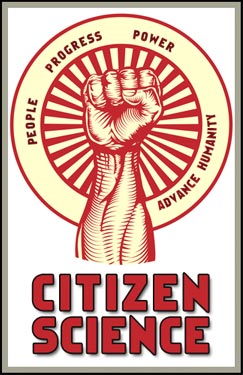 Believed to be the largest, or at least most ambitious citizen-science project in North Texas, Downwinders’ Wise County Ozone Project is going where no state or federal monitoring for smog has gone before: into the only DFW “non-attainment” county without an ozone monitor.
Believed to be the largest, or at least most ambitious citizen-science project in North Texas, Downwinders’ Wise County Ozone Project is going where no state or federal monitoring for smog has gone before: into the only DFW “non-attainment” county without an ozone monitor.
Wise County is where fracking was born and the gas industry still dominates many parts of it. It’s also where a lot of everyone else’s smog accumulates. Predominant southeast winds push it from the Gulf Coast all the way to Midlothian, through the metro DFW area, and into Wise County.
Based on past computer modeling by the State itself, ozone levels are often predicted to be higher in Wise County than any other 10 DFW non-attainment counties – but there’s still no State monitors there.
That gap in local public health information is intentional and it’s that gap the Wise County Ozone Project is filling.
Northeim is already drafting plans on how best to put the monitors to the test in the field. She wants us to have the ability to use them as stationary monitoring sites, as well as be able to take them with us on the road. It’s a complex and long-term mission that Northheim says she relishes. And she’ll be putting out the “Help Wanted” sign soon as she recruits other citizen scientists and volunteers to help, so stay tuned. You too can become a citizen scientist for the public interest.
Finding Kari was a real coup. But from its founding, Downwinders has had a long and distinguished history of working with great scientists and using sound science to advance the cause of cleaner air.
Dr. Marvin Legator’s 1996 report on the State’s toxicity classification system eventually led to some changes in Austin. Dr. Stuart Batterman did a landmark public health critique of the TXI hazardous waste burning permit in the late 1990’s. Dr. Al Armendarez, an engineering professor at SMU when he started out as Downwinder’s technical adviser, left in 2009 to become the first engineer ever to be appointed as Regional Administrator for EPA. In 2015, Dr. Kuruvilla John of UNT’s Physics Department used that school’s supercomputers to reproduce the state’s air modeling for DFW outside of Austin for the first time so elected officials could see what impact new pollution controls would have.
Soon-to-be Dr. Kari Northeim is the latest effort by Downwinders to develop local DFW expertise to help solve DFW air pollution problems. Please join us in welcoming her to the cause and consider signing-on to what is sure to be another historic challenge to the Status Quo.
And Now a Word From NOT our Sponsor

A note of explanation: There are two meetings next week in DFW concerning the large and complicated Volkswagen legal settlement over the company’s lying about the air pollution its diesel vehicles emit. Each state, as well as about 20 counties in Texas, are looking to score millions for various reasons and programs.
The two DFW meetings are sponsored by Public Citizen/Texas. We love Public Citizen and when they asked us to co-sponsor these meetings, we reflexively signed-up, even without knowing the details. There are efforts around the country to use this money to electrify school and city bus systems and challenge the status quo in interesting unconventional ways that might not be possible without large wads of cash.
But…what we didn’t know at the time we agreed to be co-sponsors was that the meeting is really a larger effort by something called the Texas Clean Air Working Group – an official statewide organization of local county governments working with other officials and businesses – to solicit comments…and most likely, direct the money to their priorities.
As a result, the North Texas Council of Governments is the major local coordinating entity for the Working Group. The COG will be presenting its version of a “DFW air quality update” and helping to coordinate responses. We did not know this until last Thursday, when we asked for details of who was doing what presentations.
This is problematic for Downwinders at Risk on a couple of fronts.
For one thing, NTCOG is one of the reasons DFW is STILL in violation of the Clean Air Act after 26 years. They have a perpetually overly optimistic perspective. They have a close relationship with TCEQ because they get so many grants from them, and they frequently side with the State on air quality issues. They see air pollution only thru the prism of federal transportation dollars at risk over our “non-attainment: status – not public health. In 2015 citizens had to raise money to do the DFW air computer modeling that neither TCEQ nor COG would do. You aren’t going to get a very realistic picture of DFW air quality, or the need to do more about it, from a COG presentation.
Secondly, the preferred use of the VW settlement money by many of these local governments and NTCOG is either expansion or replacement of their own natural gas fleets, or supplementing existing state programs the state legislature has refused to adequately fund, like the Texas Emissions Reduction Program (TERP). In effect the goal of most of the members of the Working Group is to reinforce the status quo, not change it.
Because of these reasons, we’ve asked to be taken off the list of co-sponsors. We don’t feel comfortable with our name being used to promote a more rose-color than-real picture of DFW air pollution. or natural gas as the solution to that not-as-bad-as-it looks problem.
The suggestions made at these meetings will be channeled through the NTCOG, who has already given the state a quote for the amount of money it wants and a list of what it wants to spend it on. There is no citizens lobby being organized separately to argue for different priorities.
Looming over all of this is the fact that the Texas Commission on Environmental Quality and/or the Governor’s office determines where the state’s part of the settlement goes. So don’t expect much. In fact, Ken Paxton, the Texas Attorney General is suing over the settlement, specifically trying to eliminate the $2 billion set-aside for “zero-emissions” vehicle development as “unconstitutional.”
Paxton is also suing to get 20 Texas counties, including almost all the major urban areas, to drop their own VW suits. Why would the counties want that money? Because they don’t trust the state to spend it on improving air quality. Dallas County Commissioners Court sent the state the same message this last month when it voted to stop collecting the $6 inspection fee the state is supposed to be reimbursing to local governments for air quality programs, but instead is just sitting in the general revenue pile to cover-up cuts in other programs.
So even while local governments in Texas are already lobbying hard to get their share of money from Austin, Austin is trying to make their pool of money smaller and eliminate zero emissions vehicle funding all together. Cross-purposes? Yep. But that’s Texas government in 2017.
New Harvard Study: There is No “Safe Level” of Exposure to Smog or Particulate Matter
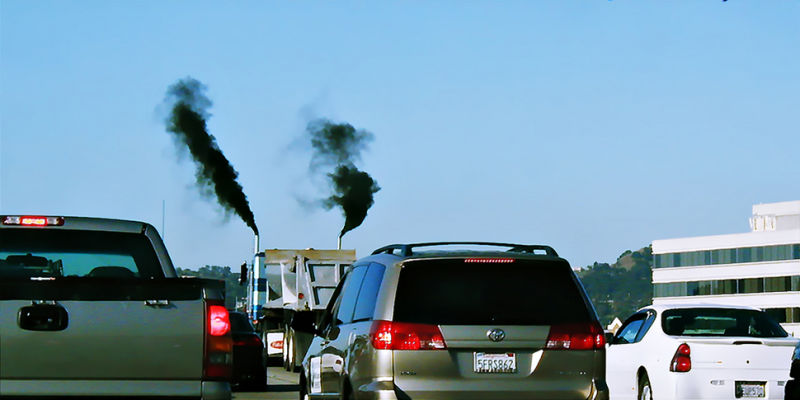
Air pollution kills thousands of Americans every year, even at levels far below the current legal limits set by the Environmental Protection Agency.
That’s the conclusion of the largest study of its kind ever done, performed by the Harvard School of Public Health and published last Thursday in the New England Journal of Medicine. It comes only a month after the Trump Administration signaled a willingness to roll back those current limits.
“Air Pollution and Mortality in the Medicare Population,” has six authors headed up by well-known Epidemiologist Joel Schwartz, of the T.H. Chan Harvard School of Public Health.
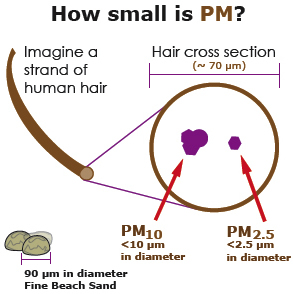
Researchers could find no sign of a “safe level” of exposure to either Ozone, aka Smog, or Particulate Matter 2.5, aka Soot at a microscopic level.
For every 1 microgram per cubic meter (µg/m³) reduction in Particulate Matter pollution, 12,000 lives were saved annually. For every 1 ppb of ozone reduction, 1,900 deaths were prevented.
Previous studies have concluded the same thing, but this new one stands out for a variety of reasons:
Size: The study followed over 61 million American seniors in the lower 48 contiguous states, representing 97% of all Americans 65 or older, for 13 consecutive years, 2000 to 2012, totaling 420 million “person-years” of follow-up and analysis.
Accuracy: Researchers developed an entirely new computer model to do the study, combining on-the ground air-monitoring data and satellite-based measurements to estimate pollution levels across the continental U.S at a resolution of 1-square-kilometer. Most current air computer models, including the ones used to predict DFW smog levels, run at a level of 5 to 10 kilometers square.
Telescoping in at the local level gave the authors the ability to estimate the levels of smog and ozone level exposures to seniors by Zip Code.
Scope: Unlike previous studies, this one’s ability to get down to the community level meant it could look at rural areas never included before. It’s size also “allowed for unprecedented accuracy in the estimation of risks among racial minorities and disadvantaged sub-groups.”
Men, Blacks, Asians, Latinos, and lower-income seniors all faced increased risk of death from exposure to Particulate Matter. Black seniors were three times more likely to die from PM exposure as the senior population as a whole.
Since the Clean Air Act (still) requires the EPA to set air quality standards that “protect sensitive populations,” a number of Environmental Justice issues, and lawsuits, might arise from the study’s findings.
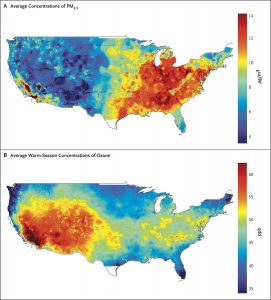
Extremely Low Levels of Pollution: With Particulate Matter, the study saw a significant increase in the risk of death rise when seniors were exposed to as little as 5 micrograms per cubic meter (µg/m³), the lowest level measured. The current EPA standard for PM exposure is 12 µg/m³. Ozone levels as low as 30 parts per billion, also the lowest measured, increased the risk of death as well. The current standard is 75 ppb, with a planned phase-in to a 70 ppb level approved by the Obama Administration in 2015 now seriously in doubt.
Seniors’ chances of dying decreased every time PM levels were decreased. However, in a strange indicator of just how harmful lower levels of pollution are, their chances of dying decreased more when those PM levels decreased BELOW the current standard of 12 µg/m³. That is, more lives were saved by cutting PM levels back from 12 to 5 µg/m³ than from say, 17 to 12 µg/m³.
PM and ozone both are primarily caused by combustion – whether it’s from engines in cars and trucks, furnaces in power plants and cement kilns, or diesels running gas and oil pipeline compressors or locomotives.
DFW’s current annual average for ozone is 80 ppb with a new 2017 average due after ozone season is completed in October. Our annual
DFW annual PM levels have averaged anywhere from 8 to almost 12 but we’ve gone over the 12 µg/m³ annual standard a number of days every year. In this 2013 study both Fort Worth and Dallas had almost 80 days above the national annual standard.
Despite its impressive size and scope, the study gives only a partial view of the public heath damage done by air pollution.
It only looks at the impacts on those 65 and older. Left out of its analysis are children, whose lungs are more sensitive because they’re not fully developed, and everyone under 65 with COPD, asthma, or other existing respiratory/cardiovascular conditions that would be exacerbated by bad air.
It also leaves out any impact short of death. This is especially important when it comes to PM pollution, which has now been linked to a number of neurological diseases like Parkinson’s, Dementia, and Autism, as well as to infertility and immune system damage. Ozone exposure can cause strokes, non-fatal heart attacks, and asthma emergencies. None of these potentially disabling results that fall short of dying are included in the damage assessment of this new study.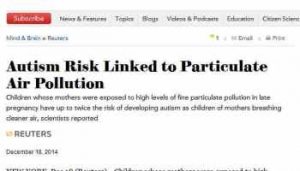
At a time when the current EPA is seeking every opportunity to roll back, cut back and turn back, this study is a large, unprecedented reminder that the current standards themselves are not protecting public health. Not even close.
Citizens must begin to fight for their lungs by reducing the exposure levels across the board, no matter the regulatory status of the pollutant, or compliance of the source. There is no safe level of industrial crap to breathe.
That means more than anti-idling zones at schools.
California has a recommended buffer zone of 500 to 1000 feet from major freeway corridors for new schools. Dallas -Forth Worth municipalities should expand this idea to daycare centers, parks and senior centers, and solidify it into policy instead of just recommendation.
Mitigation measures along those corridor using recycled water walls to “rain” down the particulate matter from traffic, or retrofitting sophisticated new air filters in homes and apartments for citizens are also needed to help those who cannot simply move away from the problem yet.
Portable monitors should be bought and distributed to help identify local PM hotspots and catch bad actors or work to lower levels of pollution. The DFW Air Research Consortium’s regional grid of sensors could be used to track PM plumes in real time.
It’s clear we’ll get no help from Austin or Washington with these efforts. Indeed, progress will be made despite them. If we have a TCEQ and EPA only interested in pollution promotion, we must fight for more pollution protection ourselves in the places where we live.
Is that a Disco Ball, or is Your Photoluminescence Experiment Just Glad to See Me?
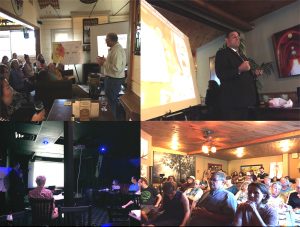
Downwinders’s “Evenings of Science and Socializing”
Concludes with SRO Crowd in Denton
We’re pretty sure it was the first time Cambridge-trained UTD Physicist Dr. David Lary had presented in a bar.
The occasion was opening night of Downwinders’ “Evenings of Science and Socializing” at Bryan Street Tavern, in a dark back room that came complete with fog machine, disco ball, and a too-close juke box.
But Dr. Lary is nothing if not persistent. He’s applied for one grant after another in trying to fund his dream of a regional grid of hundreds or thousands of air monitoring sensors. He was told not to even bother applying for a prestigious National Science Foundation grant. That would be the same grant he and his consortium of colleges, cities, and citizens groups are now in the running for. That kind of persistence is why he’s an honorary Downwinder.
And so, like the trooper he is, Dr. Lary pushed through all the distractions and pitched his plan to an audience of about a dozen and half, including wayward bar patrons who stumbled onto the exhibit and stuffed $5 dollar bills into the donation jar.
Four nights later it was Dr. David Sterling of the UNT Health Science Center explaining how his school’s partnering with the Fort Worth League of Neighborhoods gave birth to the design of the portal used by the public to access the monitoring information. His talk drew about two dozen citizens to the Ginger Man pub, including many that had been directly involved in the focus groups he had sponsored over the past five years.
And two nights after that, Dr. Lary and UNTHSC Environmental Health doctoral candidate Leslie Allsop showed up at the Greenhouse in Denton with a Standing Room Only crowd of at least 40-50 folks, plus a few latecomers who were turned away.
Some of the audience questions were the same at every meeting. How much do the sensors cost? How do we get one or more of them? Some were particular to the location or audience being addressed, like why is Denton always the “worst-performing monitor” in North Texas? Answer: location, location, location.
All of these meetings were the first time the general public had been invited to look at the technology and plans of the DFW Air Research Consortium, (DFW ARC) the less-than-year old group that’s gaining momentum in its quest to use high tech solutions to decades-old problems. Downwinders has been instrumental in establishing and administering the group. It includes the cities of Dallas, Fort Worth, Plano, the School Districts of those cities plus Richardson and the Dallas County Community College system, TCU, UTA, UNT and UTD, plus Livable Arlington and Mansfield Gas Well Awareness.
 News of the National Science Foundation grant the Consortium applied for should be coming any day now. Considering the competition, it would be quite incredible if the Consortium won. It would generate much needed publicity and increase our chances for getting other grants. But regardless, the work that went into the NSF grant has produced a template for the Consortium to apply to other foundations and individuals to grow the same regional grid of sensors. The work won’t stop if the NSF money doesn’t come through.
News of the National Science Foundation grant the Consortium applied for should be coming any day now. Considering the competition, it would be quite incredible if the Consortium won. It would generate much needed publicity and increase our chances for getting other grants. But regardless, the work that went into the NSF grant has produced a template for the Consortium to apply to other foundations and individuals to grow the same regional grid of sensors. The work won’t stop if the NSF money doesn’t come through.
Proof of that are two on-going projects of the Consortium and its members that are already up and running.
The “10-Schools” project at UTD is one where a select number of schools across the Metromess will be paired with Particulate Matter and Ozone monitors in the first attempt to sketch out the frame of a regional grid system. Selection of the schools is being weighed right now. At every meeting there was a suggestion from citizens for this or that school that should be included based on its proximity to a large pollution source, or high absentee rates. It will be tough to narrow all those suggestions down to ten.

In the Fall, the project will be distributing the monitors, being assembled now at Dr. Lary’s lab at UTD. They’ll come with a video camera, a micro meteorology unit, and the pollution sensors themselves. Students will be able to use the monitors as a tool in classes. Neighborhoods will be able to use the information to better protect themselves. It will be the beginning of building a regional grid that identifies and tracks air pollution much better than the state or EPA does now.
Then there’s Downwinder’s own “Wise County Ozone Project,” that will use the two brand new portable ozone monitors we just bought to begin recording smog levels in the one and only county in the “DFW Non-Attainment Area” that doesn’t have any. We have at least one location secured for a stationary monitor, but we need some additional assistance. To pull this off, we need:
– Carpenters that can help us assemble a couple of 12-13 foot wooden platforms that will house the monitors.
– Solar expertise and panels to help power the monitors.
– Electrical Engineers that can help us hard wire the monitors to those panels and back-up batteries.
– IT experts who can help us with connectivity issues.
If you or someone you know could be of help in any of these categories, please write us at Info@downwindersatrisk@gmail.com or call us at 469-608-1972.

What these two projects prove is the technology featured in all three of our recent events is here now and being used. We don’t have to wait. We just have to organize ourselves to make effective use of it. Help us do that. With your expertise if you have it. With your time if you can spare any. With a contribution if you can.
There are many things you may feel powerless to change right now but this is a “bricks and mortar” change on the ground that can take place over the next few years and promises to deliver a challenge to both Austin and DC. Become a part of it.
Thanks to Dr. Lary, Dr. Sterling and Ms. Allsop for donating their time and taking on the challenge of bringing science to the public..and pubs. Thanks to our co-sponsors: The Dallas Innovation Alliance, the Fort Worth League of Neighborhoods, and the Denton Drilling Awareness Group. And thanks to everyone who showed up and made these events more useful to citizens. Onward thru the Smog.
How Fort Worth Neighborhoods Helped Birth a High-Tech Regional Air Monitoring Network
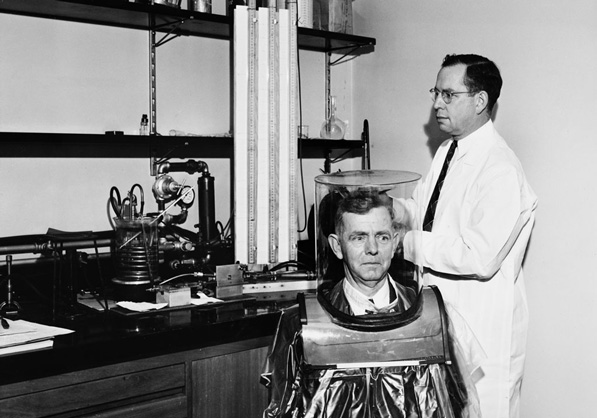
“An Evening of Science and Socializing”
Monday, June 22nd
7- 9 pm
The Ginger Man
3715 Camp Bowie
Featured Guest: Dr. David Sterling, Professor of Biostatistics and Epidemiology,
University of North Texas Health Science Center
Co-Sponsored by the Fort Worth League of Neighborhoods
They approached the leadership of the Fort Worth League of Neighborhoods, an umbrella organization of 350 neighborhood associations, about establishing a series of focus groups on the issue. The League agreed.
Those focus groups have provided us with the most thorough knowledge about community attitudes toward air quality in DFW that we’ve ever had, and directly influenced the bottom-up design of a new high-tech sensor network for air quality.
Leading those focus groups were UNTHSC Professor Dr. David Sterling and Doctoral candidate Leslie Allsop. Dr. Sterling is our featured guest tonight in Fort Worth at The Ginger Man for our second “Evening of Science and Socializing.” Ms. Allsop will be at our third and last event in Denton with Dr. David Lary on Wednesday night.
Residents in Sterling and Alsopp’s neighborhood focus groups voiced a high level of concern regarding air pollution and what they saw as the sources of it, including vehicles, fracking, and cement plants.
Participants also expressed a severe distrust of current information. They didn’t see the information available through government and media sources as being relevant to their neighborhood, or adequate to address their questions about specific emission sources.

Specifically:
• Participant’s perceptions of air quality was overwhelmingly negative, and available information was seen as being biased or unreliable.
• Within the socio-ecologic model, the primary impacts of air quality were perceived as greatest at the individual/neighborhood level.
• The ability to influence air quality at the individual/neighborhood level were perceived as negligible.
• Influencers were seen as residing at the policy and community level, but limited benefit at individual/neighborhood levels were perceived to occur.
Recognize any of these reactions? Concerned, but feeling powerless to affect the status quo.
How do you overcome this attitude? You build your own air quality monitoring network. One that’s independent of the government. One that citizens help design. One that allows you to feed information into it, as well as get much better information from it.
That’s the alternative system the DFW Air Research Consortium, including the UNTHSC researchers, is constructing from scratch.
Besides the disbursement of small e-sensors over the entire region that combine to give you a “weather map” of air pollution in real-time, one of the most distinct features of the Consortium’s new system is a digital dashboard that can collect the information a resident inputs into it.
Say you’re having a bad air day. Your eyes are watering. You have breathing problems. You check those boxes on the dashboard. The next time those conditions are forming, the dashboard will warn you. That’s the micro level.
But it will also take note of everyone else’s symptoms that were entered as well. If lots of people were also having a bad air day, it will tell you. And if people are experiencing health effects at certain levels, you’ll be able to see that in a very direct correlation. In this way citizens themselves are their own epidemiologists, with the possibility of establishing symptoms at levels of exposure to pollutants not yet linked in the literature. That’s the meta level.
All of this interactivity between user and app is traceable back to the UNTHSC’s focus groups starting four year ago. Fort Worth residents are responsible for helping to design the software to be paired with the Consortium’s sensor hardware.
Tonight in Fort Worth, UNTHSC’s Dr. Sterling gives an update about where his research has taken him and Ms. Allsop, including being in the running for a $3 million National Science Foundation grant with the rest of the Air Research Consortium. The competition includes the Argonne National Laboratory.
Libby Willis, President of the League of Neighborhoods when the research started will be there as well representing the residents who are responsible for so much of the direction of the current Project.
Besides the larger NSF grant awaiting a decision, two active citizen sensor projects already going on will also be discussed: Downwinders’ own Wise County Ozone Project and a grant that will allow the pairing of 10 sensors with ten DFW schools.
You don’t have to wait until 2018 to resist the anti-environmental agenda so in vogue in Austin and Washington. You can help build an alternative now.

